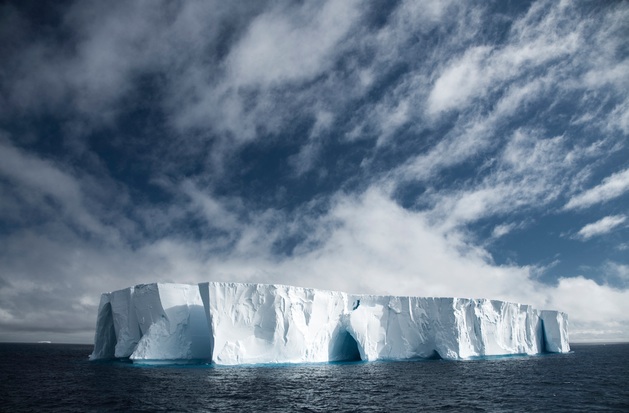
New research indicates the Arctic Ocean traps more energy from far-infrared radiation than previously estimated, which is likely contributing to the warming of the polar climate.
Scientists have identified a mechanism that could turn out to be a big contributor to warming in the Arctic region and melting sea ice.
The research was led by scientists from the US Department of Energy’s Lawrence Berkeley National Laboratory (Berkeley Lab). They studied a long-wavelength region of the electromagnetic spectrum called far infrared. It’s invisible to our eyes but accounts for about half the energy emitted by the Earth’s surface. This process balances out incoming solar energy.
Despite its importance in the planet’s energy budget, it’s difficult to measure a surface’s effectiveness in emitting far-infrared energy. In addition, its influence on the planet’s climate is not well represented in climate models. The models assume that all surfaces are 100 percent efficient in emitting far-infrared energy.
That’s not the case. The scientists found that open oceans are much less efficient than sea ice when it comes to emitting in the far-infrared region of the spectrum. This means that the Arctic Ocean traps much of the energy in far-infrared radiation, a previously unknown phenomenon that is likely contributing to the warming of the polar climate.
Their research appears this week in the online early edition of the Proceedings of the National Academy of Sciences.
“Far-infrared surface emissivity is an unexplored topic, but it deserves more attention. Our research found that non-frozen surfaces are poor emitters compared to frozen surfaces. And this discrepancy has a much bigger impact on the polar climate than today’s models indicate,” says Daniel Feldman, a scientist in Berkeley Lab’s Earth Sciences Division and lead author of the paper.
“Based on our findings, we recommend that more efforts be made to measure far-infrared surface emissivity. These measurements will help climate models better simulate the effects of this phenomenon on the Earth’s climate,” Feldman says.
He conducted the research with Bill Collins, who is head of the Earth Sciences Division’s Climate Sciences Department. Scientists from the University of Colorado, Boulder and the University of Michigan also contributed to the research.

This simulation, from the Community Earth System Model, shows decadally averaged radiative surface temperature changes during the 2030s after far-infrared surface emissivity properties are taken into account. The right color bar depicts temperature change in Kelvin. (Credit: Berkeley Lab).
The far-infrared region of the electromagnetic spectrum spans wavelengths that are between 15 and 100 microns (a micron is one millionth of a meter). It’s a subset of infrared radiation, which spans wavelengths between 5 and 100 microns. In comparison, visible light, which is another form of electromagnetic radiation, has a much shorter wavelength of between 390 and 700 nanometers (a nanometer is one billionth of a meter).
Many of today’s spectrometers cannot detect far-infrared wavelengths, which explains the dearth of field measurements. Because of this, scientists have extrapolated the effects of far-infrared surface emissions based on what’s known at the wavelengths measured by today’s spectrometers.
Feldman and colleagues suspected this approach is overly simplistic, so they refined the numbers by reviewing published studies of far-infrared surface properties. They used this information to develop calculations that were run on a global atmosphere climate model called the Community Earth System Model, which is closely tied to the Department of Energy’s Accelerated Climate Model for Energy (ACME).
The simulations revealed that far-infrared surface emissions have the biggest impact on the climates of arid high-latitude and high-altitude regions.
In the Arctic, the simulations found that open oceans hold more far-infrared energy than sea ice, resulting in warmer oceans, melting sea ice, and a 2-degree Celsius increase in the polar climate after only a 25-year run.
This could help explain why polar warming is most pronounced during the three-month winter when there is no sun. It also complements a process in which darker oceans absorb more solar energy than sea ice.
“The Earth continues to emit energy in the far infrared during the polar winter,” Feldman says. “And because ocean surfaces trap this energy, the system is warmer throughout the year as opposed to only when the sun is out.”
The simulations revealed a similar warming effect on the Tibetan plateau, where there was five percent less snowpack after a 25-year run. This means more non-frozen surface area to trap far-infrared energy, which further contributes to warming in the region.
“We found that in very arid areas, the extent to which the surface emits far-infrared energy really matters. It controls the thermal energy budget for the entire region, so we need to measure and model it better,” says Feldman
The research was supported by NASA and the Department of Energy’s Office of Science.
###
Lawrence Berkeley National Laboratory addresses the world’s most urgent scientific challenges by advancing sustainable energy, protecting human health, creating new materials, and revealing the origin and fate of the universe. Founded in 1931, Berkeley Lab’s scientific expertise has been recognized with 13 Nobel prizes. The University of California manages Berkeley Lab for the U.S. Department of Energy’s Office of Science. For more, visit www.lbl.gov.
DOE’s Office of Science is the single largest supporter of basic research in the physical sciences in the United States, and is working to address some of the most pressing challenges of our time. For more information, please visit the Office of Science website at science.energy.gov/.
Additional information:
- A paper describing this research, entitled “Far-infrared surface emissivity and climate,” is published the week of Nov. 3, 2014, in the online early edition of the Proceedings of the National Academy of Sciences.
